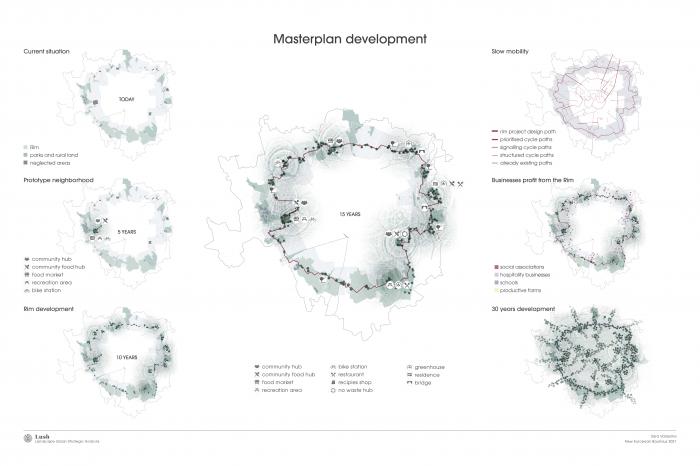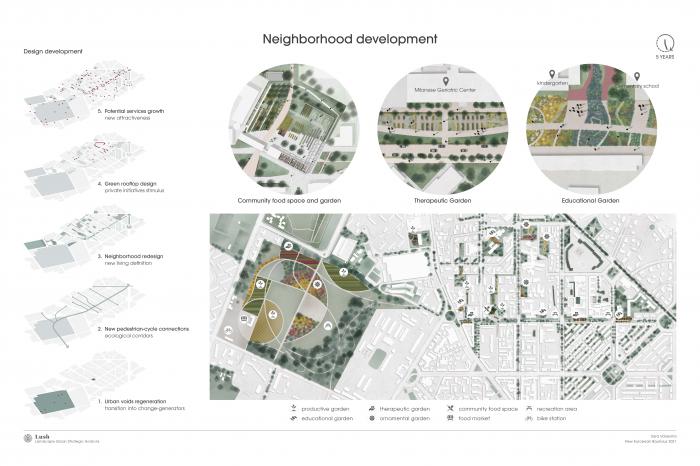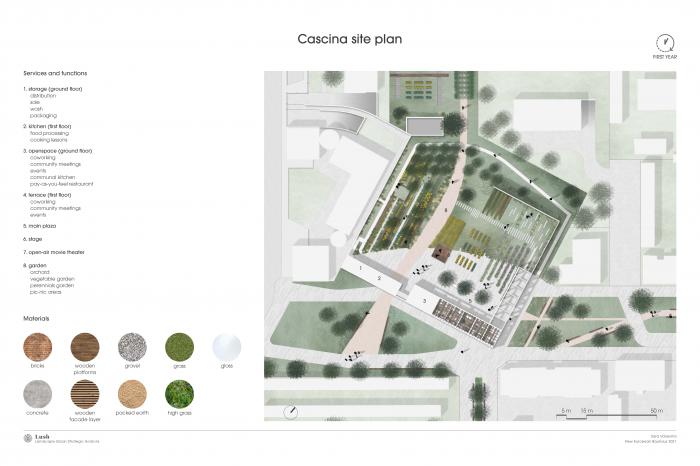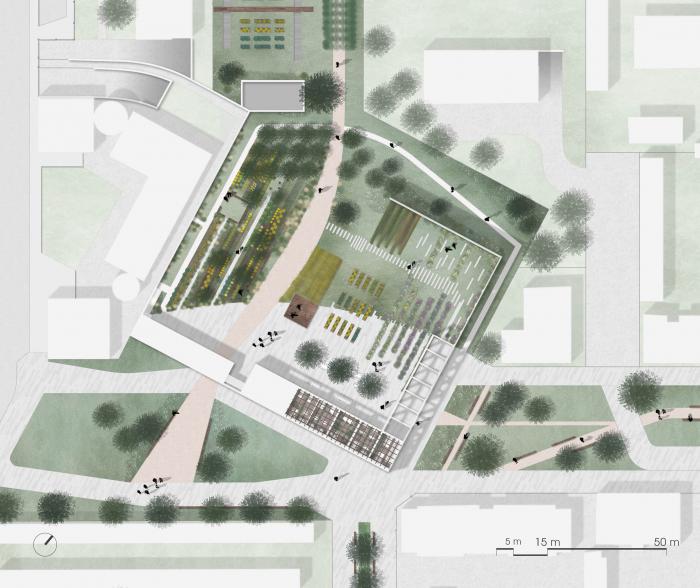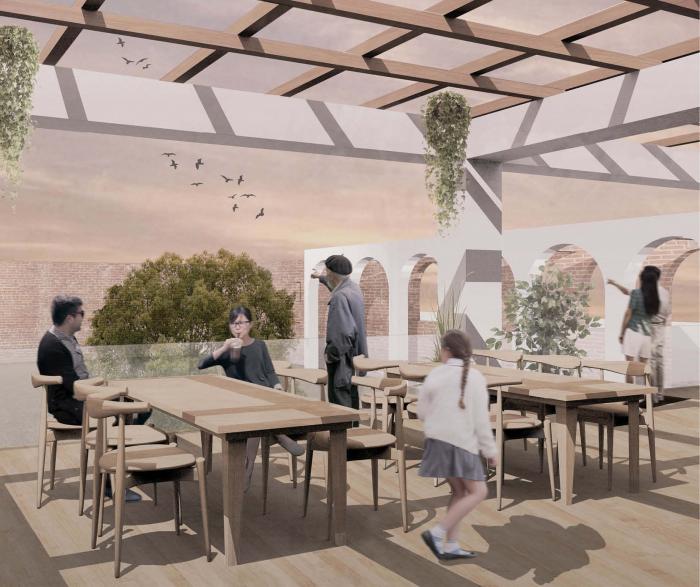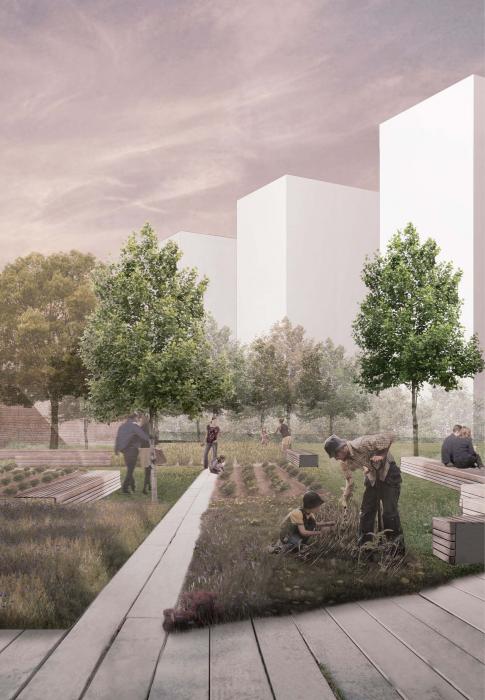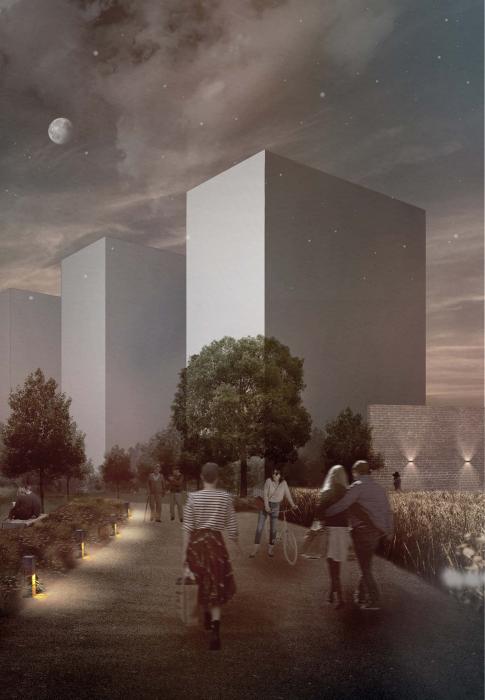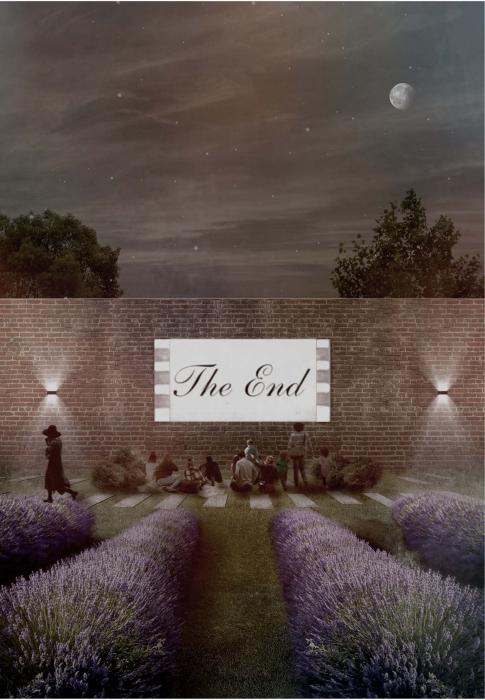I. SUMMARY INFORMATION
Project
268076
Status
Submitted
Award category
Regenerated urban and rural spaces
You want to submit
NEW EUROPEAN BAUHAUS RISING STARS : concepts or ideas submitted by young talents (aged 30 or less)
Project title
LUSH. Landscape Urban Strategic Horizons
Full concept/idea title
LUSH. Landscape Urban Strategic Horizons.
Description
LUSH (Landscape Urban Strategic Horizons) is an urban regeneration project. It initiates a profound transformation process to define a resilient city able to mitigate climate change and strengthen the local community. This project establishes the guidelines for Milan's sustainable development, redesigning public spaces as a source for citizens' wellbeing and interconnecting the urban center with the surrounding rural environment.
Where is your concept/idea being developed or intended to be implemented in the EU?
Italy
Lombardia
Via Paravia
45°28'12.5"N
9°07'45.9"E
Milano
20148
II. DESCRIPTION OF THE PROJECT
Please provide a summary of your concept/ idea
LUSH is a multiple-scales regeneration project that defines a resilient city able to mitigate climate change and strengthen the local community.
It emerges in a specific neighborhood of Milan to then spreads like wildfire along the circular crown around the city center, where densely built-up area meets and interconnects with the rural territory: the 'Rim.'
Once the Rim regeneration is complete, the project propagates around the city, following the guidelines of the first prototype-neighborhood, designed as a blueprint for subsequent replications.
A new 'Green' pervades the urban fabric in this neighborhood, becoming a strategic social and ecological regeneration tool.
'Active Green' becomes a lively and dynamic environmental component that promotes citizens' involvement in its growth and evolution.
It transforms the neighborhood into a healthier, safer, more welcoming, and more attractive habitat.
It permeates roads, commuting them in shady and fragrant gardens. It creates new educational and therapeutic open-air realities and defines areas to cultivate healthy local products of the earth.
Its greatest potentialities are expressed in an abandoned rural complex's reconversion: the Cascina Ca' Nuova. This neglected plot is transformed into a new multifunctional gathering center for the local community. Here, neighbors can cultivate the land, enjoy being outdoors, cook together, organize events and meetings, co-working and co-studying, and give life to new inclusive businesses.
Active Green becomes thereby a socializing, sharing, cultural exchange, and leisure opportunity.
To sum up, LUSH's primary objectives are 7: strengthening the local community, creating ecological corridors, increasing urban biodiversity, facilitating green mobility, promoting inclusive businesses, raising awareness about sustainability, and shifting collective mindsets and behaviors.
Please give information about the key objectives of your concept/idea in terms of sustainability and how these would be met
LUSH's masterplan develops around the whole city of Milan.
Its development strategically starts from the circular crown around the city center, where the densely built area meets/collides with rural territory remnants.
From here, the project will evolve through the years, expanding intensely on how many poorly exploited spaces as possible: redesigning neglected areas first, streets, unutilized private gardens, flat rooftops of public and then private buildings.
The Active Green strategy, applied firstly to the Rim and then to the entire metropolis, will generate an innovative urban scenario, a background for new sociability, a reinforcement of neighborhood communities, a novel way to interact, know each other, and share experiences and knowledge.
Moreover, it will enrich the urban biodiversity, mitigate urban overheating, improve air and soil conditions, and connect people and nature, fostering the enrichment of both.
Lastly, it will implement slow mobility providing new pedestrian and cycle connections, encouraging people to slow down and experience the renewed, welcoming, and safe city differently.
Active Green strategy increases the green surface on the territory and proposes different greenery and services for ecologically, socially, and economically sustainable urban development.
Thanks to new ornamental, productive, educational, and therapeutic gardens, it can: be climate-adaptive for environmental resilience, promote biodiversity, provide for soil resiliency and soil health, protect and increase human health benefits, provide for the connection of people with nature to the enrichment of both, accelerate of organic waste recycling, promote social responsibility, foster community, placemaking, and social resilience, incorporate education and outreach for awareness, produce healthy food and provide for food safety, and promote sustainable economic benefits and opportunities.
Please give information about the key objectives of your concept/idea in terms of aesthetics and quality of experience beyond functionality and how these would be met
LUSH's masterplan is an Active Green development strategy. Active Green means dozens of vegetation exploitation possibilities. The masterplan includes horticultural gardens, ornamental gardens, orchards, woodland areas, gardens with therapeutic aims close to health facilities, gardens with educational purposes next to schools (on public soil or inside their private property). Multiple ecological corridors create shady passageways full of colors and perfumes. Rooftop gardens become a recreative oasis available to residents. Vast productive gardens support new marketplaces where to sell locally produced products. Other gardens are cultivated collectively or individually under joint management up to the local community.
The regeneration of neglected macro-areas is the first transformation step. After the conversion, these areas will become strategic hot spots and initiators of change, reconnecting the city, implementing green, and becoming a background of recreational activities and new services. They will provide indoor and outdoor gathering spaces to meet, support each other, cook together and share meals and significant events. The continuous and coherent urban transformation will be influenced by territorial configurations, needs and desires of local citizens, and opportunities to be seized.
These new/regenerated attractive locations will be strategically placed along ecological corridors.
From the main green conduit, secondary green corridors will branch off, pervading the neighborhood and creating new spatial relationships. Districts will be redesigned. Roads' vehicular-pedestrian equilibrium will be re-thought, public spaces will be made more fully and easily accessible. At the same time, some private areas will be expropriated for public utility favoring the project's fluidity.
A new welcoming, aesthetically pleasing, safe environment will be generated. The city will become an enjoyable background for a new sustainable way of living.
Please give information about the key objectives of your concept/idea in terms of inclusion and how these would be been met
LUSH proposes new inclusive practices and businesses. It actively involves citizens in its growth. It asks for neighbors' cooperation in taking care of their district cultivating mutual support and new relationships.
Taking shape firstly in difficult/unprivileged urban contexts, it wants to support disadvantaged categories living in "ghettos" with a bad reputation. It will redesign the urban fabric providing new services and promoting tourism in those urban areas that are usually avoided by travelers and citizens.
The project offers locals the possibility to grow fruit and vegetables firsthand in shared gardens. It also envisages pay-as-you-feel catering realities. Buildings in need of renovation that dotted the city will be converted into restaurants managed by local associations to promote a new (for the Milanese territory) pay-as-you-feel philosophy. In this way, everyone, including people in need, can have a meal to eventually pay through volunteering for a few hours in the kitchen or the productive garden. These cooking-eating spaces can also be available directly to the community. Locals can cook and have meals together in a spirit of sharing. Same spaces can be rented for events, used for meetings, transformed into co-working, co-studying locations, adapted for cooking lessons and exploited as a means of inclusion and personal and collective growth.
Gardens will be designed as multi-purpose spaces with several benefits. Therapeutic gardens close to health facilities will facilitate vulnerable groups' access to a safe, comfortable, and pleasant environment, where to rest, stroll, gather, and cultivate the land.
The same happens in educational gardens close to school areas. They will offer the young generation an enjoyable context where to foster manual and social skills and learn about sustainability, ecology, sustainable food choices, and local and seasonal product value.
Please explain the innovative character of your concept/ idea
LUSH regenerates neighborhoods affecting people's lifestyle and mood. In regeneration, the vegetation easily infiltrates the urban fabric and revolutionizes its identity relatively quickly. Different ways, types, uses, benefits, and layouts of green can be designed to make the landscape varied and even more attractive, a characterizing environment suited to local needs and always to be discovered. The Active Green is the green to take care of as a synecdoche of the entire neighborhood and, by extension, the city. The active involvement of citizens makes them more aware of the challenges facing the city;
it makes them proud of the place they live in by connecting them with the nature that they have cultivated;
it gives them a sense of belonging to the neighborhood and the community;
it strengthens interpersonal relationships and mutual support between neighbors;
it creates new leisure opportunities that stimulate sociability and productivity;
it raises awareness and educates citizens on fundamental issues of sustainability, whether it concerns the environment and the effects of climate change, the society, the disadvantaged categories, and the concept of inclusion, nutrition, and choices of local and seasonal products.
Finally, an Active Green favors the development of new local businesses which, coexisting with cosmopolitan ones, aim to create a new, more sustainable economic balance.
More than "innovative," LUSH is a "contemporary" project. It merges cities under development with their rural origins and context. It gave space to recovery and restoration before ex Novo constructions. It calls citizens to cooperate, to be conscious, engaged, and actively involved in significant changes. It establishes new nature-built-up, vehicular-pedestrian balances to favor new ways of living and experience the city. It proposes new solutions for slow tourism and strengthens the identity of local districts.
Please detail the plans you have for the further development, promotion and/or implementation of your concept/idea, with a particular attention to the initiatives to be taken before May 2022
LUSH's urban regeneration is a long process that starts in a specific district (prototype neighborhood). In this neighborhood, huge neglected areas are the first to be redesigned and converted into the project's hot spots. A historical rural complex (Cascina Ca' Nuova) dating back to XVII has been chosen as the first leading project site to restore and transform.
It is a historical landmark that testifies to the rural reality that once characterized the city of Milan. However, today it is not valorized. It is left on its own, abandoned, neglected. Hence, the site offers countless opportunities and challenges. The first-year intervention will:
redesign the urban fabric to valorize the Cascina instead of marginalizing it;
exploit the court-space and the areas in front of it to improve public green and promote pedestrian and cycle mobility;
recover the rural identity reintroducing productive gardens that the community can cultivate;
renovate the only remained historical building purposing new businesses and service for the local community;
program activities, events, different uses to make it an active and attractive center, also experiment new initiatives that are not practiced yet on the Milanese territory (communal kitchen services, pay-as-you-feel restaurants...);
favor spaces' multifunctionality, making them adaptable to several uses depending on different situations and demands.
This urban regeneration's ultimate goal (architectural renovation and services' purposes included) is to allow citizens to reappropriate their neighborhood, promoting ecological, social, economic sustainable behaviors.
The Cascina then will be integrated into an ecological corridor crossing the neighborhood creating new pedestrian/cycleways and laying the foundation for new potential services. Natural materials will be combined with existing concrete. Main paths will be made of beaten earth, gravel, or natural stone, transferring a character of the countryside to the middle of the city.
III. UPLOAD PICTURES
IV. VALIDATION
By ticking this box, you declare that all the information provided in this form is factually correct, that the proposed concept/idea has not been proposed for the New European Bauhaus Rising Stars Awards more than once in the same category.
Yes
